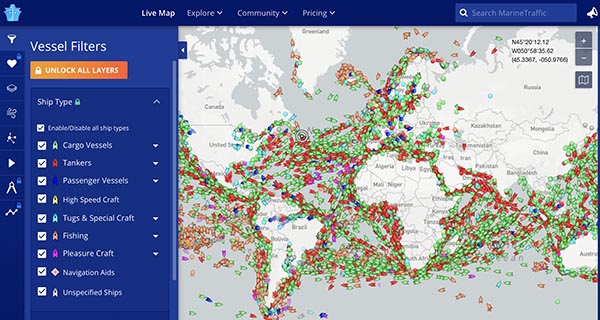Your Friday Drone Footage of an Erupting Icelandic Volcano
All the Newsletters that Are Fit to Send
Do you subscribe to WhatTheyThink’s daily newsletter? Of course you do. You probably subscribe to many others, as well, and, despite the fact that you probably delete untold numbers of email messages sight unseen, you probably regularly read the newsletters you have signed up for. The Atlantic had a story this week about how, in the face of changing preferences in communication methods, the humble newsletter continues to thrive.
Interestingly, the newsletter was invented in ancient Rome, and took off during the Middle Ages.
Cut to 2020, when the 14 million customers of a single email platform called Mailchimp sent out 333,635,013,035 newsletters that, among other things, drove more than $64 billion in revenue.
…The typically digestible length, coupled with the simple, minimalist format—an easily shareable, single page of content written on papyrus, pecked out on a typewriter, or thumbed on an iPhone—helps explain the longevity. But the solid fuel-thruster that rocketed the newsletter format to the edge of the atmosphere during the decades since your 14.4K modem first connected to the web, and that has pushed it into the stratosphere in 2021, is the newsletter’s inseparability from its ancient-by-internet-standards delivery mechanism: email.
But how does it bypass the morning mass deletion ritual?
Newsletters are patient. I send something to you, and you can read it when you want to and respond (or not) when you want to. You get to absorb and consider the contents of a newsletter without the rest of the internet chiming in, telling you what to think while puking out tweets, replies, posts, comments, photos, videos, news, and memes at a pace that pulverizes human attentional capacity. (The second you catch up, you’re already behind.) Newsletters are always right where you left them. Sure, people complain about having too much email. But compared with everything else online, your inbox is the Walden Pond of the internet.
As much as email inboxes can be overwhelmed by crap, they’re still better than social media newsfeeds.
And this—the plague of news feeds—brings us to the best thing about newsletters: They give you home-court advantage. Thanks in part to humanity’s success against the scourge of spam, the inbox is one of the few places where you actually have control over an information feed. If you want a newsletter, subscribe. If you don’t want a newsletter, unsubscribe. Mark Zuckerberg doesn’t get to decide what’s more likely to appear in your email stream.
Empathy
"We’re sorry this package has experienced a sortation delay" is a pretty amazing sentence. pic.twitter.com/B5AFgUb5vr
— Merlin Mann (@hotdogsladies) November 17, 2021
Gimme an Ink with Hair…Long Beautiful Hair
For those who have it, hair has its advantages, but there is often the need to cut it and then someone needs to get rid of it. Can discarded hair be used to make other useful things? Well, it can be used to make wigs, hair can be donated to places like Locks of Love, which uses it to fashion wigs for people who have been rendered hairless due to chemo, alopecia, etc. However, via Core77, industrial designer Martijn Rigters has launched a project called “The Colour of Hair”: “by considering hair as a useful material rather than a material to evoke distasteful emotion, ‘The Colour of Hair’ proposes controlled and sustainable printing wonders.” His project is based on a means of turning human hair into a kind of ink.
Drawing inspiration from traditional ceramic techniques, the process uses natural fibers to create a surface treatment and decorative patterns on a diverse range of metals. By applying the hair to a carefully heated surface, the material carbonises instantly and acts as a form of ink that has similarities to etching and anodising. This reaction is caused by the hair's main protein, keratin. The transformation during this process is permanent and durable.

It has kind of a “floor of a barbershop” aesthetic.
Rigters is currently working on expanding the kinds of materials his printing process uses and is experimenting with wool, cashmere, and fish scales. Fish scales? Actually, pet hair would be a useful material that many people have in abundance.
Amtrakkin’
Took the train to Syracuse instead of flying because I wanted the autumn in New York experience and the train hit a deer and someone is yelling You Done Hit Bambi and a drunk woman is threatening to strip if they don’t turn the heat down; my fault for not being more specific.
— Danielle Evans (@daniellevalore) November 16, 2021
Signs of the Apocalypse, Part the First: DogPhone
Have you ever wished, while you were away from home, that your dog could call you? No, nor did we, but now s/he can. Says The Guardian:
The device – nicknamed the DogPhone – is a soft ball that, when moved, sends a signal to a laptop that launches a video call, and the sound of a ringing telephone.
The owner can choose whether to take the call, and when to hang up, while they can also place a call to their pet – although the dog has to move the ball to pick up.
Dogs are clever, so after a few times they’ll come to realize that when you send the call to voicemail after two rings you’re intentionally avoiding them.
… “This is just one way to demonstrate that dogs can control technology,” said Hirskyj-Douglas. “We can build technology for dogs.”
While a canine social media, or FaceBark, has yet to be created, Hirskyj-Douglas said she envisages a future where dogs could call each other.
Just envisioning this is amusement enough. And we can’t wait until dogs start texting.
We jest, but it’s actually not a bad idea in those cases where dogs get separation anxiety, which was the idea behind the DogPhone.
Hirskyj-Douglas said the technology could bring benefits to pets, in particular dogs who struggle with being separated from their owners – although she admitted the device had actually caused her some anxiety.
The problem they discovered was, even after several demonstrations, the dog had no idea what it was doing, so they’ve basically invented the idea of dog butt-dialing.
By the way, they could probably make such a thing for cats, but what would be the point?
A Dog’s Life
Philosophy studies.
— Mollie Katzen (@MollieKatzen) November 16, 2021
via @puppyofworld_ig pic.twitter.com/dLJPJ1cpg7
Lost in MySpace
We here in the Around the Web Cultural Accretion Bunker are no strangers to nostalgia (heck, we’re in the printing industry), but a curious form of nostalgia just appeared on our screen: MySpace nostalgia. Say what? No, say Hey. Says Lifehacker:
The last time you heard about MySpace was probably when the site accidentally deleted the 50 million songs during a server migration in 2018. But after the last 5+ years of world-shaking social media vitriol, in rolls the MySpace-themed platform SpaceHey, a “retro social network” that claims to be focused on privacy and customizability, but also sweet, sweet nostalgia. It’s currently making headlines, attracting a recent surge of 200,000 new users.
Lifehacker asks, “does this ‘new’ network have anything to offer users who were too young to experience the, uh, heyday of the site that inspired it?” What about those of us who were too old to want to experience heyday of the site that inspired it? (Actually, some of us were on MySpace for about five minutes. It cured us of later wanting to have anything to do with Facebook.)
The writer of the article—a Gen Zer who is probably the target audience for SpaceHey—hives it an approving tryout.
While you can take some precautions to make Facebook (slightly) less evil and invasive, you can’t help the fact that it was designed to mine your data for all it is worth. But at SpaceHey, all-powerful algorithms are still a thing of the future. Instead, your feed is chronological, and the user experience doesn’t feel designed to keep you doom-scrolling indefinitely. SpaceHey’s greatest selling point might be the fact that it doesn’t bombard you with targeted ads, suggest friends from your contacts, or directly promote content your way. Vintage!
Coming soon: Friendster nostalgia!
Grate Expectations
You'll never be as lazy as whoever named the fireplace
— Jason (@longwall26) March 12, 2015
Letting the Furby Fly
Remember Furbies, the hot toy of the late 1990s? It was kind of a talking doll that began babbling in its own language (“Furbish”) but was programmed to begin using English words and phrases over time. The Furby was an early attempt at a home robot which some people found endearing, and others found freakish.
Speaking of freakish, via Laughing Squid, Sam Battle, a builder and player of unusual instruments and young mad scientist (by the looks of it), took a Furby—which he gave the endearing name of Subject 44b—and integrated it into a modular synthesizer.

The Furby is controlled by these switches over here. There’s a glitch switch, a loop switch, there’s one that rubs its belly, there’s one that feeds it, and then another one that turns it well…makes it think it’s going upside down.
If this doesn’t haunt your dreams, nothing will:
Horsing Around
This is the best metaphor for machine learning I have ever seen. https://t.co/I11asLyrwp
— Alistair Croll (@acroll) November 15, 2021
Lowering the Bar
In the scifi cartoon Futurama, a recurring character is iZac, a robot bartender based on Isaac, the bartender on The Love Boat, played by the iconic Ted Lange.

Anyway, are real-life iZacs looking to put Isaacs out of work? Says the BBC:
Enter Cecilia, a robotic bartender that mixes and serves cocktails, and uses artificial intelligence (AI) to talk to customers in much the same way that Alexa, on an Amazon Echo speaker, or Siri, on an iPhone can respond to you.
The unit looks a bit like a tall fruit machine, only with an animated female barmaid - Cecilia - appearing on a large, upright video screen. You either tell her what cocktail you want, or order it on the below touch-screen, and pay for the drink by tapping your bank card or phone.
Your cocktail is then mixed and made inside the machine, and dispensed into a glass at the vending slot.
You can buy Cecilia for $45,000 or rent it for $2,000 a month. The idea is to make a bar run more efficiently.
"The main issue when you have a venue is constant problems with the workforce," says Alan Adojaan. He is the chief executive of Yanu, an Estonian company that recently unveiled a rival bartending robot.
Hmm…it’s hard to imagine why people are quitting the service industry. Anyway, in our experience, talking with airport bartenders is often a high point of travelling. Or was.
Should Isaac be worried?
Emanuele Rossetti, the boss of Italian robot bartender maker Makr Shakr, says that while some barmen and women will lose their jobs, the hope is that they can find alternative work within the wider hospitality sector.
To help affected human bar staff do just this it launched an initiative in the US in 2019, whereby for each sale of one of its units it would give a barman or woman $1,000 (£747) towards helping them retrain.
Mark Shakr's two robot models are called Toni and Bruno, and they have been installed on nine Royal Caribbean cruise ships. They cost from 99,000 euros ($114,000; £85,000).
Still:
"Robots will not replace traditional [human-staffed] bars," says Jan Hiersemenzel, the head of marketing for Swiss firm F&P Robotics, which makes a robot bar server called Barney Bar.
"Standalone robot bars are [instead] being set up at entertainment and hospitality venues, or at events where otherwise no traditional bar would have been set up."
Entering the Chrysalis
Queen has 'entered a new phase' and we 'may not see her until February', say experts https://t.co/smvURSXkCe
— MSN UK (@msnuk) November 17, 2021
What will she emerge as?
When My Ship Comes In
Speaking of The Love Boat, ever since we read about supply chain disruptions, crowded ports, and ships waiting endlessly offshore top dock, we have become obsessively glued to marinetraffic.com, a real-time tracker of all maritime vessels.

That’s a lot of boats! Granted, they’re not to scale, and depending on the zoom in/out level, one can get the impression that they are huge boats. But still…
You can sort by ship type, and get even more detailed information like capacity, tonnage, origin and destination, and more, but most of those features requires a paid plan, and we’re not that obsessive. Still, pretty heat, huh?
Any Color Christmas You Want
Thanks to these supply chain issues, I'm having trouble buying Xmas presents. Some people just aren't going to get the color of shipping container they asked for.
— J. Elvis Weinstein (@JElvisWeinstein) November 16, 2021
Getting a Charge Out of Graphene
Was it a good week for graphene news? It’s always a good week for graphene news! Elecjet’s new Apollo Ultra battery pack uses graphene to dramatically speed up charging. says The Verge:
Yes, graphene, that miracle material that has long promised to change the world, allows this 10,000mAh portable battery to charge from zero to full in less than 30 minutes, about five to six times faster than a conventional power bank of the same capacity. Plug it in when you wake up and the Apollo Ultra should be fully charged by the time you leave the house.
Hey, Verge, don’t you be mocking graphene!
Not Just British Problems
“Sorry I was late to the Zoom call, I was sitting ready in anticipation for an hour then clicked the wrong thing with one second to go”
— VeryBritishProblems (@SoVeryBritish) November 17, 2021
Dream Weaver
Unspun, a manufacturer of custom jeans based on individual 3D body scans, has just added another arrow to its quiver—3D weaving! This is a capability the company has been working on for several years and expects to begin using to deliver product in early 2022. The invention was recognized by TIME Magazine in its Top 100 best inventions of 2021!
a machine that 3-D-weaves yarn into a one-of-a-kind pair of jeans ($200–$215) tailored to fit individual buyers. Each made-to-order pair starts with a body scan (which can be done on an iPhone) capturing 30,000 data points to create a design in the fabric and style the customer chooses. Unspun then uses its topographical weaving machine to produce the jeans in just 10 minutes.
All Maps Amazing and Terrible, Part the Infinity
Average flag colour by latitude pic.twitter.com/MIsUAqoRhO
— Amazing Maps™ (@amazingmap) April 9, 2020
Portugal is actually smaller than Spain pic.twitter.com/AHdlm3sCxA
— Terrible Maps (@TerribleMaps) October 24, 2021
Unjudging a Book
This headline from CNN conjured up some bizarre mental images: “This library lets you borrow people instead of books.” Sure, you pick someone off a shelf, the librarian stamps the due date on him or her, and you have two weeks to return them. But that’s not how it works, and there actually is a noble purpose behind what is called The Human Library.
Every "human book" from this library represents a group that faces prejudice or stigmas because of their lifestyle, ethnicity, beliefs, or disability. A human book can be an alcoholic, for example, or a Muslim, or a homeless person, or someone who was sexually abused.
The Human Library stages in-person and online events where "difficult questions are expected, appreciated, and answered." Organizers says they're trying to encourage people to "unjudge" a book by its cover.
It was created 21 years ago by Ronni Abergel, a Danish human rights activist and journalist who wanted to see if a “human” library could bring people together the way a proper library does.
"I had a theory that it could work because the library is one of the few places in our community where everyone is welcome, whether you're rich or poor, homeless or living in a castle, professor or illiterate," he says. "It's truly the most inclusive institution in our time."
And it seems to be a hit.
Abergel’s idea has spread like a bestseller. The Human Library has hosted events in more than 80 countries, in libraries, museums, festivals and schools. It has more than 1,000 human books in circulation in more than 50 languages, with an especially strong presence in American cities such as Chicago and San Francisco, Abergel says.
You only get a “book” for 30 minutes, so there is no need to worry about cleaning out a closet and finding a library book you unwittingly had for 25 years.
Sandy Claws
Great song, hope they do it justice. pic.twitter.com/X0kNp6ybWM
— Simon Blackwell (@simonblackwell) November 17, 2021
2020 Hindsight
A brace of stories this week had such a 2020 feel to them. First, in Egypt, heavy rains brought flash flooding which in turn swept hundreds of scorpions out of their burrows and into cities and towns. Says The New York Times:
There were hundreds, if not thousands: yellowish four-inchers with as many as six pairs of eyes and a tail full of venom so toxic that the species is known, unscientifically, as the deathstalker.
Swept from their desert burrows by the rains, they came skittering into mountainside villages and burst into homes through cracks in the walls, stinging at least 503 people on Friday night alone, according to local officials.
Then, climate change has driven armadillos further north than is usual for them—and one North Carolina town was invaded by the mammals. Says The Guardian:
Homeowners, perturbed at their lawns being torn up by the newly arrived mammals, initially deputized Bullard as a sort of armadillo bounty hunter, handing him $100 for every dead carcass he produced. But armadillos have wreaked such horticultural havoc that dozens of people in and around Sapphire, North Carolina, now have Bullard on a retainer, allowing him to prowl around their properties at night, armed, in the hope of shooting the culprits.
… “It’s only a matter of time before we see range expansions into other states,” said Colleen Olfenbuttel, furbearer biologist at the North Carolina wildlife resources commission. The agency confirmed the first armadillo in North Carolina in 2007 but numbers have rocketed in the western half of the state since 2019. “It’s challenging to deal with armadillo damage. They are hard to trap and I don’t know if there’s a repellent for them,” said Olfenbuttel. “I’m as curious as anyone as to where they will pop up next.”
We can’t wait to check in and see what the murder hornets are up to.
Fried
Please just roast the damn turkey like normal Americans. https://t.co/EnGfXZxwiT
— Charles P. Pierce (@CharlesPPierce) November 16, 2021
The Staff of Life
Christmas is coming, and if you have a bread lover in your life, what could be a better gift than this giant bread plushie?

Available in either 31.4 or 39.3 inch options, an odd choice…
Bread plush cushions can be found anywhere, such as beds, sofas, chairs, bikes, home decor, holiday dresses, etc., a very interesting experience.
Bikes? Dresses? A very interesting experience indeed!
Child’s Play
OK, it’s probably tacky to include a tweet of our own here, but this image was too amusing to let it fade into Twitterblivion.
We use the phrase “let’s talk turkey” when Thanksgiving is just over a week away…or we want the other party to know that it’s time to get to the bottom line: https://t.co/ORXkY8Uhn8 pic.twitter.com/NnGqfUvlG7
— WhatTheyThink (@whattheythink) November 16, 2021
Have a great Thanksgiving!
This Week in Printing, Publishing, and Media History
November 15
1926: The NBC radio network launches with 24 stations.
1968: The Cleveland Transit System becomes the first transit system in the western hemisphere to provide direct rapid transit service from a city's downtown to its major airport.
1971: Intel releases the world’s first commercial single-chip microprocessor, the 4004.
November 16
534: Justinian I, who was an Eastern Roman (Byzantine) emperor in Constantinople, approves and publishes the second and final revision of the Codex Justinianus.
1889: American director, producer, and playwright George S. Kaufman born.
1904: English engineer John Ambrose Fleming receives a patent for the thermionic valve (aka the vacuum tube).
1914: The Federal Reserve Bank of the United States officially opens.
1938: LSD is first synthesized by Albert Hofmann from ergotamine at the Sandoz Laboratories in Basel.
November 17
1749: French chef Nicolas Appert born. He invented the principle of canning.
1790: German mathematician and astronomer August Ferdinand Möbius born. (It’s not true that his life had no beginning and no end.)
1839: Oberto, Giuseppe Verdi's first opera, opens at the Teatro alla Scala in Milan, Italy.
1944: College basketball coach Jim Boeheim born.
1947: American scientists John Bardeen and Walter Houser Brattain observe the basic principles of the transistor, a key element for the electronics revolution of the 20th century.
1968: Viewers of the Raiders–Jets football game in the eastern United States are denied the opportunity to watch its exciting finish when NBC broadcasts Heidi instead, prompting changes to sports broadcasting in the U.S.
2019: The first known case of COVID-19 is traced to a 55-year-old man who had visited a market in Wuhan, Hubei Province, China. And so it begins…
November 18
1787: French physicist and photographer, and inventor of the daguerreotype, Louis Daguerre, born.
1836: English playwright and poet W. S. Gilbert born.
1865: Mark Twain’s short story “The Celebrated Jumping Frog of Calaveras County” is published in the New York Saturday Press.
1883: American and Canadian railroads institute five standard continental time zones, ending the confusion of thousands of local times. Well, it was about time.
1922: French author and critic Marcel Proust dies (b. 1871).
1928: Release of the animated short Steamboat Willie, the first fully synchronized sound cartoon, directed by Walt Disney and Ub Iwerks, featuring the third appearances of cartoon characters Mickey Mouse and Minnie Mouse. This is considered by the Disney corporation to be Mickey’s birthday.
1963: The first push-button telephone goes into service.
November 19
1909: Austrian-American theorist, educator, and author Peter Drucker born.
1916: Samuel Goldwyn and Edgar Selwyn establish Goldwyn Pictures.
1954: Télé Monte Carlo, Europe’s oldest private television channel, is launched by Prince Rainier III.
1955: National Review publishes its first issue.
1959: The Ford Motor Company announces the discontinuation of the unpopular Edsel.
1967; The establishment of TVB, the first wireless commercial television station in Hong Kong.
1998: Vincent van Gogh’s Portrait of the Artist Without Beard sells at auction for US$71.5 million.
2006: Nintendo's first video game console with motion control, the Wii, is released.
November 20
1805: Beethoven's only opera, Fidelio, premieres in Vienna.
1908: British-American journalist and author Alistair Cooke born.
1910: Russian author and playwright Leo Tolstoy dies (b. 1828).
1924: Polish-American mathematician and economist, and coiner of the term “fractal,” Benoit Mandelbrot born.
1936: American novelist, essayist, and playwright Don DeLillo born.
1969: The Plain Dealer publishes explicit photographs of dead villagers from the My Lai Massacre in Vietnam.
1985: Microsoft Windows 1.0 is released.
November 21
1676: The Danish astronomer Ole Rømer presents the first quantitative measurements of the speed of light.
1694: French historian, playwright, and philosopher Voltaire (né François-Marie Arouet) born.
1783: In Paris, Jean-François Pilâtre de Rozier and François Laurent d’Arlandes, make the first untethered hot air balloon flight.
1877: Thomas Edison announces his invention of the phonograph, a machine that can record and play sound.
1898: Belgian painter René Magritte born.
1902: Polish-American novelist and short story writer, Nobel Prize laureate Isaac Bashevis Singer born.
1905: Albert Einstein’s paper that leads to the mass–energy equivalence formula, E = mc², is published in the journal Annalen der Physik.
1945: American humorist, newspaper columnist, and actor Robert Benchley dies (b. 1889).
1969: The first permanent ARPANET link is established between UCLA and SRI.















Discussion
Only verified members can comment.